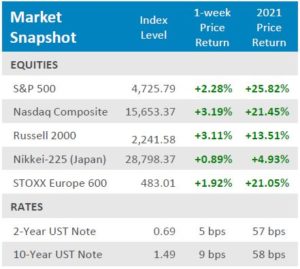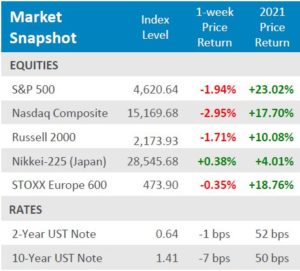US Markets were finally able to post a positive week in some areas but are still deeply in the red year to date. International equities were still negative on the week and the year thus far.
Week-in-Review: Week ending in 01.21.22
Even with US Markets closed on Monday for Martin Luther King Jr. Day, global equities continued their steady selloff throughout the week.
Week-in-Review: Week ending in 01.14.22
Global equities continued their selloff for the week as market participants digested hawkish statements from Federal Reserve officials.
Week-in-Review: Week ending in 01.07.22
Global equities sold off for the first week of the year as market participants switched into risk-off mode as they priced in a more hawkish Fed.
Month-in-Review: December 2021
The month of December initially began with traders pricing in a new covid-19 variant’s impact (omicron variant) on markets, but eventually shook off their concerns and turned their attention back to the Federal Reserve.
Week-in-Review: Week ending in 12.31.21
Despite low volume during the final week of the year, global equities were mostly in the green for the week, solidifying robust returns for the year of 2021.
Week-in-Review: Week ending in 12.24.21
The Bottom Line
● Traders shook off omicron concerns and the hawkish Fed from last week and grinded out a new record for equities despite the shortened trading week.
● Yields climbed with equities for the week, the yield on the 2-year dropping slightly, up +5bps and the yield on the 10-year jumped +9bps.
● Economic data for the week illustrated that the economy is still rebounding, despite the myriad of constraints in supply-chains, labor markets, and runaway inflation, with GDP coming in above estimates and Personal Consumption showing consumers are returning to spending for the holiday season.
Santa Clause Rally: ✔ Year End Rally: ?
After last week’s abysmal sell-off in equity markets, investors shrugged off rising omicron cases and the hawkish tone of the Fed. The S&P 500 closed at a record high on Thursday, clinching a Santa Clause rally, markets were closed on Friday in observance of the Christmas holiday. The S&P 500 was up +2.28% for the week and a whopping +25.82% for the year. After bearing a large brunt of the selling pressure last week, the tech-heavy Nasdaq was able to post a strong week, up +3.19% for the week. Small Cap equities, as measured by the Russell 2000, were right behind the Nasdaq, up +3.11% for the week. International equities participated in the rally as well, albeit to a lesser extent, the STOXX Europe 600 was up +1.92% for the week and Japanese equities, as measured by the Nikkei-225, were up a modest +0.89%. Strong US GDP numbers, as well as strong Personal Consumption, helped buoy the rally for the week, showing that consumers are shaking off the continued concern of the spread of covid-19 variants. With a Santa Clause rally officially in the books for the year, the big question now is if it will continue into the final week of the year. Economic data releases for next week will be light due to the New Year’s holiday and another short trading week.
Digits & Did You Knows
IMPACTING MANY – 45% of American households surveyed in November of 2021 indicate that rising domestic inflation has caused “moderate” or “severe” hardship. (source: Gallup, BTN Research)
HOME LOANS – Government-backed mortgages, e.g., FHA or VA loans, make up 50% of all home mortgages. The maximum government-backed mortgage loan in 2022 in a majority of the US will be $647,200. In high-cost areas of the country, the maximum loan will be $970,800. (source: Federal Housing Finance Agency, BTN Research).
THEY’RE IN EVERYTHING – 75% of the semiconductor chips manufactured in the world today are made in Asia. Just 12% of all chips are made in the USA. (source: Semiconductor Industry Association, BTN Research.)
Click here to see the full review.
—
Source: Bloomberg. Asset‐class performance is presented by using market returns from an exchange‐traded fund (ETF) proxy that best represents its respective broad asset class. Returns shown are net of fund fees for and do not necessarily represent performance of specific mutual funds and/or exchange‐traded funds recommended by the Prime Capital Investment Advisors. The performance of those funds may be substantially different than the performance of the broad asset classes and to proxy ETFs represented here. U.S. Bonds (iShares Core U.S. Aggregate Bond ETF); High‐YieldBond(iShares iBoxx $ High Yield Corporate Bond ETF); Intl Bonds (SPDR® Bloomberg Barclays International Corporate Bond ETF); Large Growth (iShares Russell 1000 Growth ETF); Large Value (iShares Russell 1000 ValueETF);MidGrowth(iSharesRussell Mid‐CapGrowthETF);MidValue (iSharesRussell Mid‐Cap Value ETF); Small Growth (iShares Russell 2000 Growth ETF); Small Value (iShares Russell 2000 Value ETF); Intl Equity (iShares MSCI EAFE ETF); Emg Markets (iShares MSCI Emerging Markets ETF); and Real Estate (iShares U.S. Real Estate ETF). The return displayed as “Allocation” is a weighted average of the ETF proxies shown as represented by: 30% U.S. Bonds, 5% International Bonds, 5% High Yield Bonds, 10% Large Growth, 10% Large Value, 4% Mid Growth, 4%Mid Value, 2% Small Growth, 2% Small Value, 18% International Stock, 7% Emerging Markets, 3% Real Estate.
Advisory products and services offered by Investment Adviser Representatives through Prime Capital Investment Advisors, LLC (“PCIA”), a federally registered investment adviser. PCIA: 6201 College Blvd., Suite#150, Overland Park, KS 66211. PCIA doing business as Prime Capital Wealth Management (“PCWM”) and Qualified Plan Advisors (“QPA”).
© 2021 Prime Capital Investment Advisors, 6201 College Blvd., Suite #150, Overland Park, KS 66211.
Week-in-Review: Week ending in 12.17.21
The Bottom Line
● With the Fed turning hawkish, equity markets retreated from their record highs set last Friday, both domestically and across the pond in Europe.
● Yields fell with equities for the week, the yield on the 2-year dropping slightly, down -1bps and the yield on the
10- year falling -7bps.
● Economic data for the week showed that inflation is still hitting manufacturers hard with PPI coming in hotter than expected and housing data showed that the real estate market is still running red hot with both Housing Starts and Building Permits come in above expectations.
Fed Turns Hawkish
Retreating from last Friday’s record high, the S&P 500 was in the red almost everyday for the week, except for Wednesday when Fed Chairman Powell made remarks after the Federal Reserves meeting. To combat runaway inflation, Powell announced that the Fed will accelerate the pace at which they are tapering their asset purchase program, increasing the reduction from $10 billion to $20 billion per month starting next month. After the dust had settled, the S&P 500 lost -1.94% for the week, with Small Caps, as measured by the Russell 2000, right behind it, down -1.71% for the week. The tech heavy Nasdaq faced the worse of the selling pressure, falling -2.95% for the week. European equities, as measured by the STOXX Europe 600, were down slightly -0.35% for the week after the European Central Bank (ECB) also announced a tapering to their asset purchases, but also promised that additional stimulus would be coming. Japanese equities, as measured by the Nikkei-225, was able to cling onto positive territory for the week, up +0.38%. With the week turning negative, a Santa Claus rally is in jeopardy, but not impossible. Looking out the next week, market participants will be looking to GDP numbers, as well as personal income and spending data releases.
Digits & Did You Knows
EVERYBODY IS PAYING LESS – The Tax Cuts and Jobs Act of 2017 was signed into law by President Trump on 12/22/17 and became effective on 01/01/18. The average tax rate paid by the top 1% of taxpayers, i.e., federal income tax paid divided by adjusted gross income, dropped from 26.76% in 2017 to 25.57% in 2019. The average tax rate paid by the bottom 90% of taxpayers dropped from 8.38% in 2017 to 7.36% in 2019 . (source: IRS, BTN Research).
AS LONG AS I’M HERE – Just 1 out of every 11 employees (9%) who were auto-enrolled in their companies’ 401(k) plans opt out of their participation in the pre-tax retirement plan. (source: Fidelity, BTN Research)
Click here to see the full review.
—
Source: Bloomberg. Asset‐class performance is presented by using market returns from an exchange‐traded fund (ETF) proxy that best represents its respective broad asset class. Returns shown are net of fund fees for and do not necessarily represent performance of specific mutual funds and/or exchange‐traded funds recommended by the Prime Capital Investment Advisors. The performance of those funds may be substantially different than the performance of the broad asset classes and to proxy ETFs represented here. U.S. Bonds (iShares Core U.S. Aggregate Bond ETF); High‐YieldBond(iShares iBoxx $ High Yield Corporate Bond ETF); Intl Bonds (SPDR® Bloomberg Barclays International Corporate Bond ETF); Large Growth (iShares Russell 1000 Growth ETF); Large Value (iShares Russell 1000 ValueETF);MidGrowth(iSharesRussell Mid‐CapGrowthETF);MidValue (iSharesRussell Mid‐Cap Value ETF); Small Growth (iShares Russell 2000 Growth ETF); Small Value (iShares Russell 2000 Value ETF); Intl Equity (iShares MSCI EAFE ETF); Emg Markets (iShares MSCI Emerging Markets ETF); and Real Estate (iShares U.S. Real Estate ETF). The return displayed as “Allocation” is a weighted average of the ETF proxies shown as represented by: 30% U.S. Bonds, 5% International Bonds, 5% High Yield Bonds, 10% Large Growth, 10% Large Value, 4% Mid Growth, 4%Mid Value, 2% Small Growth, 2% Small Value, 18% International Stock, 7% Emerging Markets, 3% Real Estate.
Advisory services offered through Prime Capital Investment Advisors, LLC. (“PCIA”), a Registered Investment Adviser. PCIA doing business as Prime Capital Wealth Management (“PCWM”) and Qualified Plan Advisors (“QPA”).
© 2021 Prime Capital Investment Advisors, 6201 College Blvd., Suite #150, Overland Park, KS 66211.
Week-in-Review: Week ending in 12.10.21
Domestic and International equities shook off last week’s volatility and posted a strong week of gains.
Month-in-Review: November 2021
Equities, especially international, plummeted for the month of September as the delta variant continued to work its way through populations and a new variant threatens the globe.










